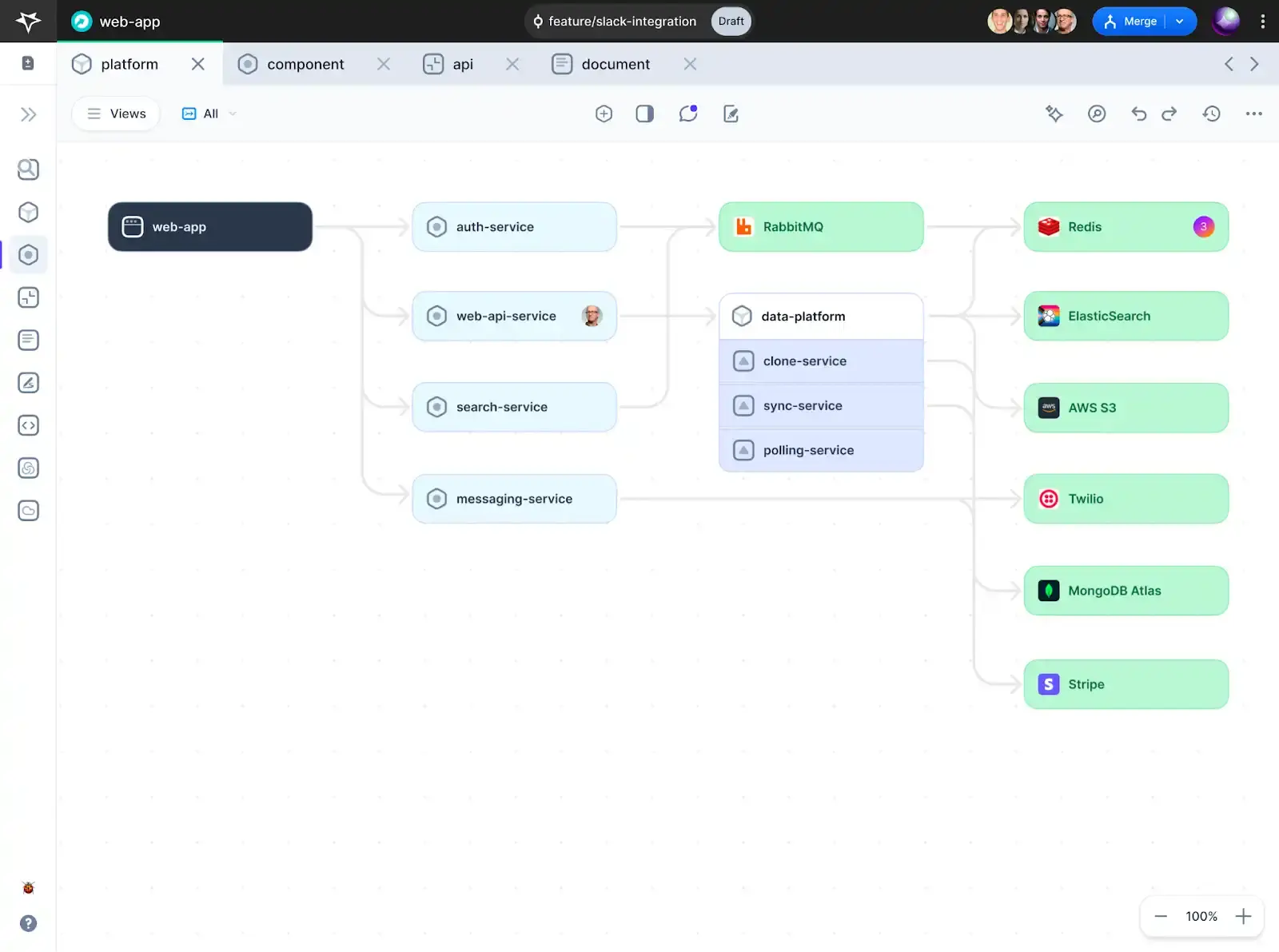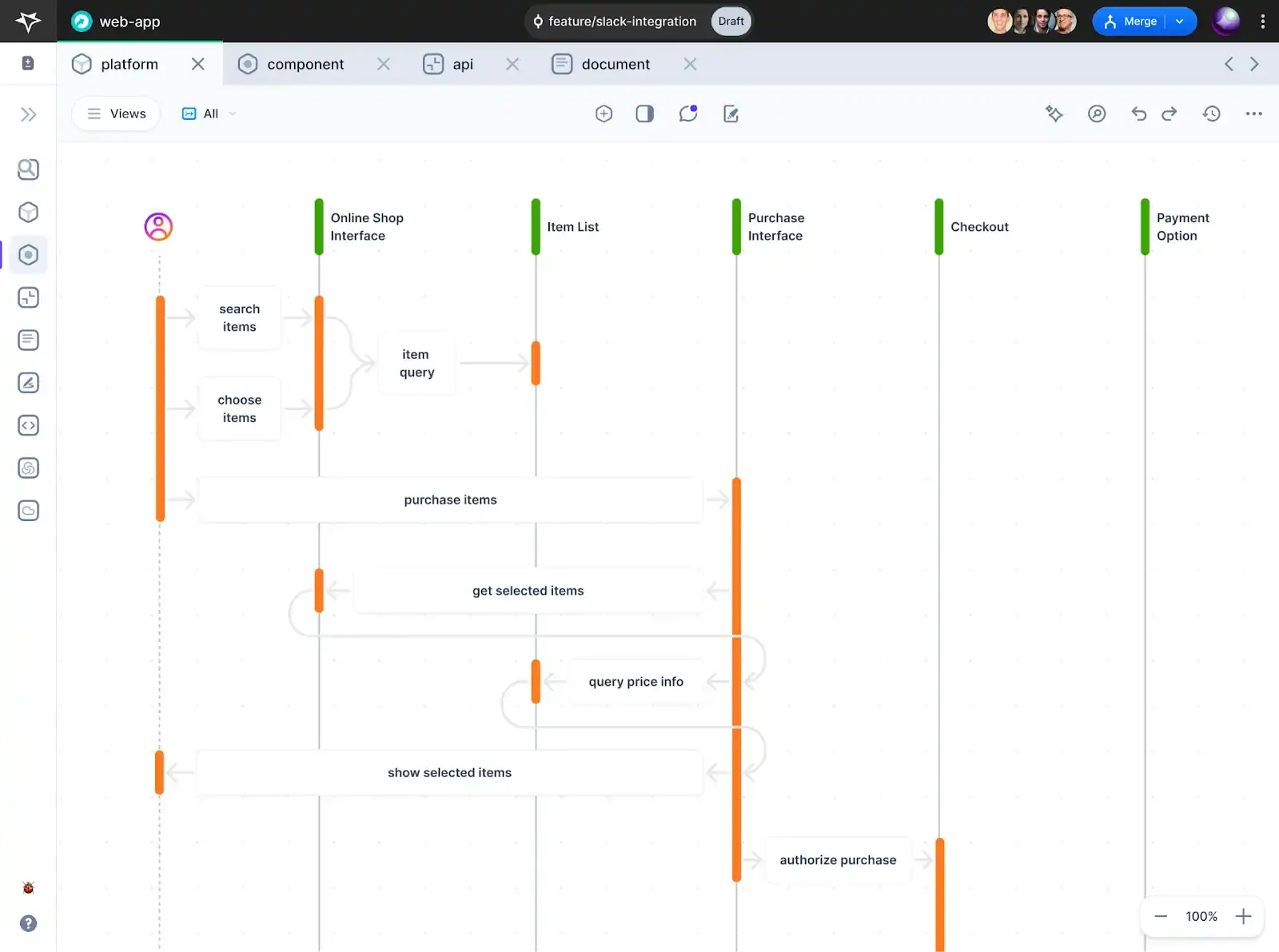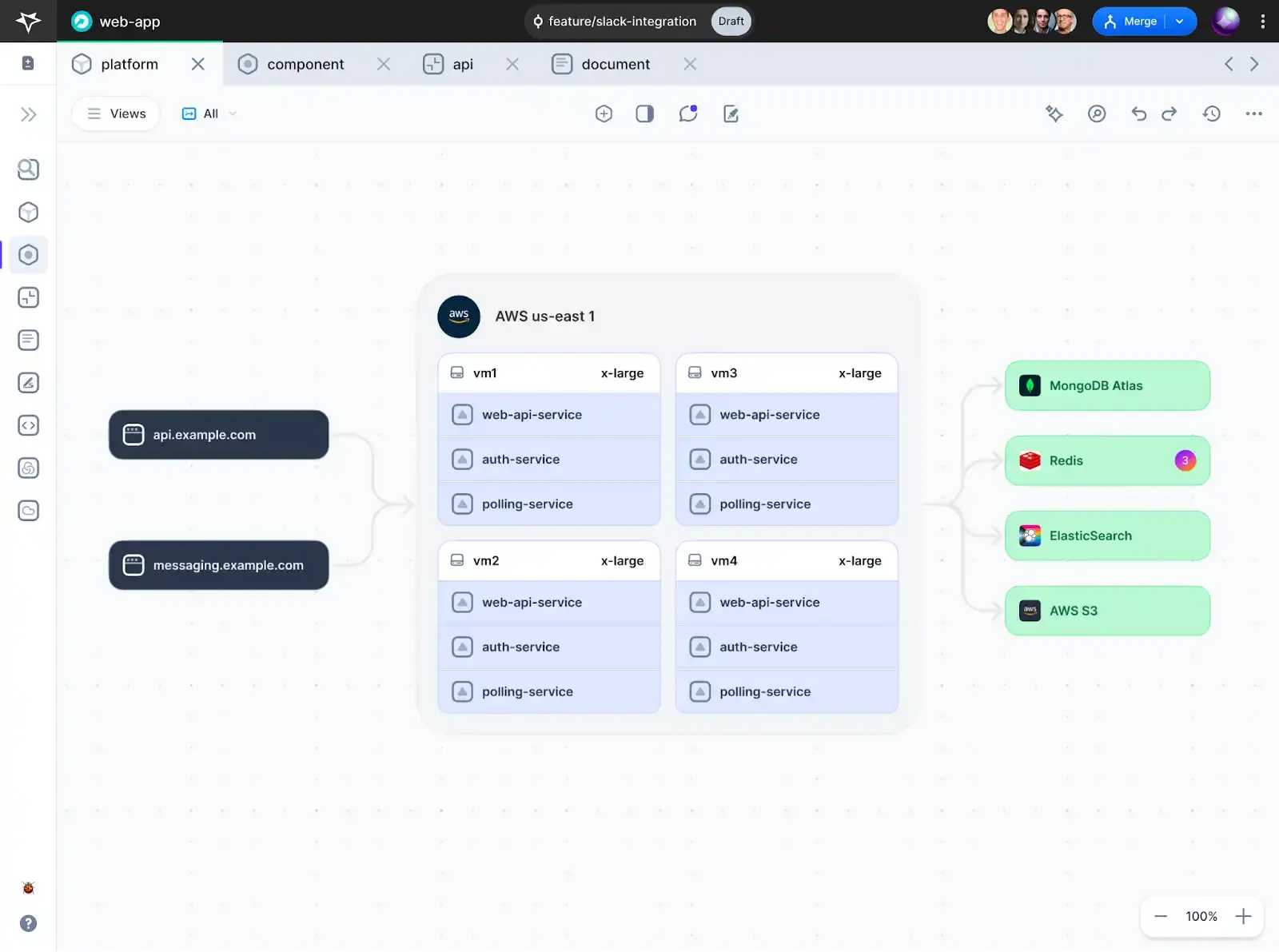Guide
Software Architecture Documentation: Tutorial & Best Practices
Table of Contents
Software architecture documentation is critical for modern development teams because it provides a blueprint for the entire software development process. Clear and comprehensive documentation enables effective communication among stakeholders, including developers, designers, testers, and project managers, ensuring everyone understands the system's structure, components, and interactions. It facilitates better decision-making by providing insights into design choices, trade-offs, and constraints, thus minimizing the risk of misunderstandings, errors, and rework. Moreover, architecture documentation is a reference for future maintenance, enhancements, and scalability, allowing teams to maintain system integrity and coherence over time.
Ultimately, investing in robust software architecture documentation promotes efficiency, collaboration, and the successful delivery of high-quality software products. This article will cover the key concepts and challenges of creating and maintaining quality software architecture documentation.
Summary of key software architecture documentation concepts
The table below summarizes the essential software architecture documentation concepts this article will explore.
| Key concept | Description |
|---|---|
| Why is software architecture documentation important? | To create and maintain quality software, capturing and communicating architecture is critical. |
| The impact of neglecting software architecture documentation | Failing to incorporate good documentation practices into a project’s workflow can increase technical debt and lead to negative and costly effects on project outcomes. |
| Different types of diagrams for reflecting software architecture | Architecture, sequence, and network diagrams document and provide visual references for different system perspectives. |
| The case for dynamic diagrams | The ability to dynamically create and maintain diagrams ensures artifacts stay relevant and valuable. |
| Documentation as a source of truth | Centralizing system information as an aggregation of linked resources creates a single source of truth for reference across the development team. |
| Understanding stakeholders’ documentation needs | By using decomposition and custom views, you can create documentation that is relevant and accessible to various stakeholders. |
| Integrating software architecture documentation into the agile lifecycle | Creating and maintaining documentation is critical and should be incorporated into all facets of the agile process. |
Why is software architecture documentation important?
Investing in comprehensive software architecture documentation is essential for fostering collaboration, mitigating risks, and ensuring the long-term success of software projects. Documentation serves as a blueprint for the development team, providing a clear roadmap of the system's structure, components, and interactions. It helps developers understand the high-level system design, easing collaboration between teams and contributing to better consistency throughout the project lifecycle.
Software architecture documentation is also one of the most important developer onboarding documents because it enables new team members to understand the system's architecture and contribute sooner and more effectively. Without proper documentation, developers may overlook the software's intricacies, which leads to inefficiencies, errors, and development delays.
Moreover, software architecture documentation plays a vital role in communication with stakeholders. Documenting architectural decisions, rationale, and trade-offs helps bridge the gap between technical and non-technical stakeholders, enabling better decision-making. Clear documentation also facilitates discussions about system requirements, constraints, and potential risks, ensuring that everyone involved understands the project's goals and constraints.
Finally, effective documentation is a reference for future enhancements, troubleshooting, and maintenance activities, empowering teams to evolve the software efficiently.
The impact of neglecting software architecture documentation
Neglecting software architecture documentation can significantly negatively impact a project, including development, collaboration, maintenance, and the product's overall success.
Below are six common results of neglecting software architecture documentation.
- Misalignment and miscommunication: Without clear and up-to-date documentation, developers may interpret the system's architecture differently, leading to inconsistencies, conflicts, and misunderstandings in implementing features and functionalities.
- Increased technical debt: Neglecting architecture documentation often leads to shortcuts, workarounds, and ad-hoc solutions to address immediate needs. These suboptimal solutions can cause unresolved design and implementation issues that hinder future development efforts and increase the cost of maintenance and refactoring.
- Reduced maintainability and scalability: Inadequate documentation makes it more challenging to understand the system's design, dependencies, and interactions. As a result, developers often face difficulties maintaining and scaling poorly documented systems.
- Difficulty in onboarding and knowledge transfer: Lack of documentation makes it challenging to onboard new team members and transfer knowledge within the team. New developers may need help understanding the system's architecture and design decisions, resulting in longer ramp-up times and decreased productivity. Moreover, knowledge gaps may emerge when experienced team members leave the project or organization, leading to a loss of institutional knowledge and expertise.
- Risk of system failure and security vulnerabilities: Inadequate documentation increases the risk of system failure and security vulnerabilities. Without a clear understanding of the system's architecture and dependencies, developers may inadvertently introduce errors, bugs, or security flaws during development or maintenance activities, jeopardizing the software product's integrity, reliability, and security.
- Compliance and audit challenges: Neglecting architecture documentation can make meeting regulatory requirements, industry standards, and compliance obligations challenging. Auditors and regulatory bodies may require documentation to demonstrate adherence to established guidelines and practices, and the absence of such documentation can lead to compliance issues and regulatory penalties.
Teams must prioritize creating and maintaining architecture documentation to mitigate these risks and ensure the long-term success of their software projects. In the sections that follow, we explore different methods and best practices for doing so.
Different types of diagrams for reflecting software architecture
By utilizing different types of diagrams, software architects can effectively communicate the various aspects of the system's architecture to stakeholders, developers, and other project team members, facilitating better understanding, collaboration, and decision-making throughout the software development lifecycle.
The following sections will review three of the most important categories of system architecture diagrams.
System architecture diagrams
System architecture diagrams provide an overview of the system's architecture and key components. They visualize the relationships between these elements at a high level, allowing stakeholders to gain an understanding of the overall structure and design of the system.

Example system architecture diagram
In the example above, each service or component is represented as a separate entity. The diagram does not reveal implementation details but rather presents the design of the system as a whole. This level of abstraction serves as a helpful starting point for developers new to the system or for other stakeholders who wish to gain a high-level view of the system’s key components, interfaces, and third-party services.
Full-stack session recording
Learn moreSequence Diagrams
Sequence diagrams depict interactions between objects or components within a system over time. They illustrate the sequence of messages exchanged between these entities, which are typically sent to accomplish a specific task or scenario. Sequence diagrams are valuable tools for understanding the dynamic behavior of a system, particularly during runtime.

Example sequence diagram for an e-commerce website
In a sequence diagram, vertical lines–or lifelines–represent the objects or components involved in the interaction. Horizontal arrows between lifelines indicate messages being passed between them, with the sequence of messages reflecting the execution order. Depending on the timing and nature of the interaction, messages can be synchronous, asynchronous, or recursive.
Sequence diagrams help stakeholders and developers visualize the control and data flow when executing a particular scenario or use case. They provide insights into how objects collaborate to achieve a desired outcome, highlighting dependencies, interactions, and potential bottlenecks within the system.
Additionally, sequence diagrams are effective communication tools, enabling teams to discuss and refine the system's design, identify possible issues early in development, and ensure alignment between requirements and implementation. Overall, sequence diagrams play a crucial role in understanding and documenting the dynamic aspects of software architecture, facilitating effective design, implementation, and testing of complex systems.
Network Diagrams
Network diagrams are essential to software architecture development, particularly in distributed systems or applications with networked components. These diagrams visually represent the relationships and connections between various system elements, including servers, clients, databases, APIs, and other network devices.

In a network diagram, nodes represent different network entities, while edges or lines depict their connections or communication paths. This visualization helps architects and developers understand the network's topology, including its physical layout, communication protocols, and data flow patterns. Network diagrams in software architecture development serve several key purposes:
Interact with full-stack session recordings to appreciate how they can help with debugging
EXPLORE THE SANDBOX(NO FORMS)
- Visualization of network topology: Network diagrams provide a clear, graphical representation of the physical and logical layout of the network infrastructure, including servers, routers, switches, and other devices. This visualization helps stakeholders understand how different components are interconnected and how data flows through the system.
- Identification of network components: Network diagrams help identify the various network components, such as servers, databases, firewalls, and load balancers, and their respective roles in the architecture. This understanding is crucial for ensuring that the network infrastructure can support the requirements of the software application.
- Analysis of network performance: Network diagrams facilitate the analysis of network performance and scalability by visually depicting the network architecture and data flow paths. Architects can identify potential bottlenecks, single points of failure, and areas for optimization to improve the system's overall performance and reliability.
- Communication and collaboration: Network diagrams are effective communication tools. They allow architects, developers, and other stakeholders to discuss and refine the network architecture. They provide a common visual language for discussing network-related concepts and decisions, fostering collaboration and alignment across the project team.
In general, network diagrams help ensure that the network architecture effectively supports the requirements of the software application and contributes to the project's overall success.
The case for dynamic diagrams
Dynamic diagrams are developed and maintained by analyzing the underlying components and automatically modifying the diagram to reflect the system's current state.
The case for dynamically generating software architecture diagrams is compelling for several reasons, primarily stemming from the dynamic nature of modern software development environments and the need for up-to-date and accurate documentation. The table below highlights the key advantages of using dynamic diagrams with an automated tool like Multiplayer.
| Goal | Benefits |
|---|---|
| Real-time system representation | Software systems are constantly evolving, with frequent changes in codebase, architecture, and dependencies. Dynamically generating architecture diagrams allows teams to reflect these changes in real time, ensuring the documentation remains accurate and up-to-date. This real-time representation gives developers, architects, and stakeholders a clear and current understanding of the system's architecture. |
| Automation and efficiency | Manually creating and updating architecture diagrams can be time-consuming and error-prone, especially in large and complex systems. By automating the generation process, teams can save time and effort while ensuring consistency and accuracy across the documentation. Automation tools can analyze code repositories, configuration files, and other sources of information to generate architecture diagrams based on the latest system state dynamically. |
| Adaptability | Software architectures frequently change in agile and iterative development methodologies to accommodate evolving requirements, user feedback, and technological advancements. Dynamically generated diagrams can adapt to these changes seamlessly, reflecting updates in the system's structure, components, and interactions without manual intervention. This adaptability enables teams to embrace change more effectively and iterate on the architecture iteratively. |
| Collaboration and communication | Dynamic architecture diagrams are effective communication tools, enabling teams to collaborate more efficiently and share insights into the system's design and implementation. By providing a visual representation of the architecture, these diagrams facilitate discussions, brainstorming sessions, and decision-making processes among stakeholders with varying levels of technical expertise. This promotes alignment, consensus-building, and a shared understanding of the system across the project team. |
| Versioning and history tracking | Dynamically generated architecture diagrams can incorporate versioning and history-tracking features, allowing teams to track changes over time and revert to previous versions if necessary. This capability provides valuable insights into the evolution of the architecture, including the rationale behind design decisions, the impact of changes, and the progression of the system's development lifecycle. |
By leveraging automation tools and techniques to generate dynamic diagrams, teams can maintain accurate and up-to-date documentation, fostering better understanding, collaboration, and decision-making throughout the software development lifecycle.
Documentation as a source of truth
Documentation is the primary source of truth in software development, providing a comprehensive and authoritative reference for understanding the system's design, functionality, and implementation details. As software systems grow in complexity and scale, maintaining accurate and up-to-date documentation becomes crucial for ensuring clarity, consistency, and reliability across the development lifecycle.
Documentation as an aggregation of linked resources is a powerful approach to creating a comprehensive view of the system. By connecting various resources, such as code repositories, design documents, specifications, and test cases, documentation becomes more than just a static reference - it becomes a dynamic and interconnected knowledge base that reflects the entirety and dynamism of the software development process. Here are other reasons why this approach is compelling:
- Holistic representation: Aggregating linked resources allows documentation to provide a holistic representation of the software system. Instead of isolated documents or artifacts, developers can access a unified view encompassing all relevant information, from high-level architectural diagrams to detailed code implementations and test cases. This holistic representation fosters a deeper understanding of the system's structure, behavior, and evolution.
- Contextualization and navigation: Linked resources provide valuable context and facilitate navigation within the documentation. Developers can easily trace the connections between different artifacts, exploring how requirements translate into design decisions, influencing code implementations and testing strategies. This helps developers understand the rationale behind design choices and how different system components interrelate.
- Traceability and accountability: By linking resources, documentation enables traceability throughout the software development lifecycle. Developers can trace requirements to design decisions, code changes to test cases, and bugs to fixes, ensuring accountability and transparency in the development process. This helps teams track the evolution of the software system and assess the impact of changes on its overall quality and functionality.
- Dynamic updates and collaboration: Linked resources facilitate dynamic updates and collaboration within the documentation. Developers can easily update linked artifacts as the software evolves to reflect requirements, design, or implementation changes. Moreover, collaboration tools and version control systems enable multiple team members to contribute to the documentation concurrently, fostering collaboration and knowledge sharing.
- Accessibility and scalability: Aggregating linked resources makes documentation more accessible and scalable. Developers can access relevant information quickly and efficiently without searching through disparate sources or navigating complex file structures. Moreover, as the software system grows in complexity and scale, the linked documentation can accommodate new artifacts and updates, ensuring it remains a reliable source of truth over time.
Documentation as an aggregation of linked resources creates a dynamic and interconnected view of the source of truth in software development. Consider leveraging modern tools like Multiplayer to enhance collaboration, transparency, and accountability within your development team.
Understanding stakeholders’ documentation needs
Understanding stakeholders' documentation needs is essential for effectively communicating with and meeting the requirements of all parties involved in a software project.
The process begins by identifying key stakeholders, including the immediate project team, end-users, customers, executives, regulatory bodies, and others affected by the project. Once they have been identified, conduct a thorough analysis to understand each stakeholder's role, responsibilities, interests, and information needs. Consider their technical expertise level, specific concerns or priorities, and how they interact with the software. This often means engaging directly with stakeholders to gather their documentation requirements. If needed, conduct interviews, surveys, workshops, or focus groups to solicit feedback and input on the type, format, and level of detail they require in the documentation. Pay attention to any regulatory or compliance requirements.
One click. Full-stack visibility. All the data you need correlated in one session
RECORD A SESSION FOR FREENext, prioritize documentation needs based on importance and urgency. Some stakeholders may require detailed technical documentation, while others benefit more from user-friendly guides or executive summaries.
Align your documentation strategy with the project goals and objectives, and create the necessary artifacts. This may involve creating different types of documentation, such as user manuals, technical specifications, training materials, or compliance documents. Customize the content, format, and level of detail to match each stakeholder's preferences and requirements. Modern tools like Multiplayer can assist by leveraging views to decompose diagrams to a level that matches and meets the stakeholder's needs.
Finally, establish clear communication channels for sharing and discussing documentation with stakeholders. Provide opportunities for stakeholders to review and provide feedback on documentation drafts and be responsive to their input and suggestions. This allows stakeholders to engage directly with the development process from the early planning stages, and it also facilitates continuous iteration and improvement of the project structure and documentation itself, ensuring the documentation remains accurate, relevant, and valuable throughout the software development lifecycle.
Integrating software architecture documentation into the agile lifecycle
Integrating software architecture documentation into the agile lifecycle is crucial for maintaining alignment between the evolving architecture and the development process. Here is how you can seamlessly incorporate architecture documentation into each phase of the agile lifecycle:
| Development phase | Goal | Methods |
|---|---|---|
| Initial planning and sprint 0 | Create high-level architecture documentation, such as system architecture diagrams, sequence diagrams, and network diagrams. | Conduct upfront system design reviews during sprint 0 to address key architectural concerns and make informed decisions about the system's design and technology stack. |
| Sprint planning | Collaborate with the development team to identify tasks that may require updates to system architecture for upcoming sprints. | Document architectural decisions, design guidelines, and constraints based on the current status of your system architecture. This helps guide the development team as they implement new features and functionalities. |
| Sprint execution | Continuously update architecture documentation as the development progresses, capturing changes to the system's design, components, and interfaces. | Use tools like Multiplayer that automatically maintain alignment between the evolving codebase and the documented architecture. This allows developers to know the current state of the system and make better-informed decisions on how to evolve it. Continuous system design reviews also help in this process. |
| Sprint review | Review and validate architecture documentation to accurately reflect the implemented features and functionalities. | Gather feedback from stakeholders and the development team on the effectiveness of the architecture and identify any areas for improvement or refinement. |
| Sprint retrospective | Reflect on the architecture-related practices and processes, identifying successes, challenges, and opportunities for improvement. | Consider adjustments to the documentation process, tools, or methodologies based on lessons learned from previous sprints. |
| Ongoing maintenance and refinement | Ensure architecture documentation remains up-to-date and aligned with the system's current state, reflecting any changes or enhancements made during subsequent sprints. | Implement effective upfront system design review processes and utilize documentation tools that automatically and continuously update architecture documentation along with changes to the codebase. |
It is important to note that informed architecture decisions rely on a comprehensive understanding of the system’s existing architecture and its current state. To this end, storing information like architecture decisions, trade offs, dependencies, and functional and nonfunctional requirements in a centralized, accessible location facilitates better decision-making and allows more stakeholders to contribute to upfront system design processes.
Stop coaxing your copilot. Feed it correlated session data that’s enriched and AI-ready.
START FOR FREEBy following the practices above and integrating architecture documentation into the agile lifecycle, teams can balance agility and architectural rigor, ensuring that the system's design remains well-documented, adaptable, and aligned with the project's goals and requirements.
Conclusion
Software architecture documentation is an indispensable asset in the development journey, acting as the blueprint for the entire software development process. By providing clear and comprehensive documentation, teams facilitate effective stakeholder communication, ensuring everyone grasps the system's structure, components, and interactions. This transparency enables better decision-making, minimizes the risk of misunderstandings, errors, and rework, and lays a solid foundation for collaboration and innovation.
Furthermore, architecture documentation is a reference point for future maintenance, enhancements, and scalability endeavors, allowing teams to sustain the system's integrity and coherence over time. Investing in robust software architecture documentation promotes efficiency and collaboration and paves the way for the successful delivery of high-quality software products. By understanding the stakeholders' needs, integrating documentation into the agile lifecycle, and leveraging modern tools to help maintain thorough and up-to-date documentation, teams can harness the power of architecture documentation to drive project success.


